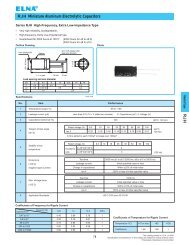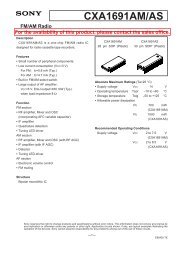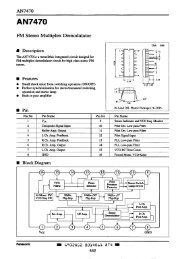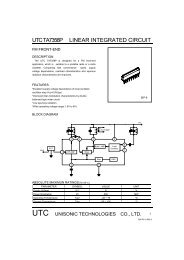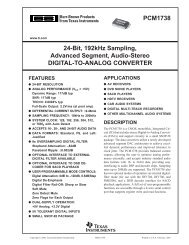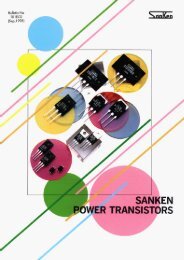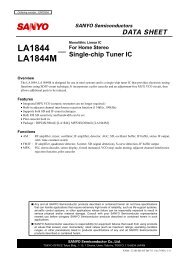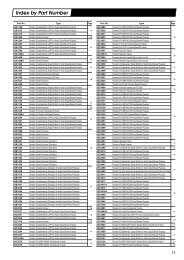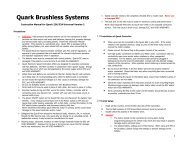1 - maxdat.eu
1 - maxdat.eu
1 - maxdat.eu
You also want an ePaper? Increase the reach of your titles
YUMPU automatically turns print PDFs into web optimized ePapers that Google loves.
1-1-1 Linear Regulator IC<br />
Application Note<br />
■ Heat dissipation and Reliability<br />
The reliability of an IC is highly dependent on its operating temperature.<br />
Please be sure to apply silicone grease to the IC and to mount it to the<br />
heatsink with a proper mounting torque.<br />
Heatsink design should pay particular attention to ensuring sufficient heat<br />
dissipation capacity.<br />
In addition, please take into account the air convection in operation.<br />
■ Calculating Internal Power Dissipation(PD)<br />
PD is given by the following formula:<br />
PD=IO • [VIN(mean)–VO]<br />
Determine the size of the heatsink according to the relationship between<br />
allowable power dissipation and ambient temperature.<br />
■ Setting DC Input Voltage<br />
The following is the waveform of a DC input voltage.<br />
Input Ripple<br />
When setting the DC input voltage, please follow the instructions below:<br />
●Make VIN(min) ≥ [ (Output voltage) + (Minimum dropout voltage) ]<br />
●Make VIN(max) ≤ DC input voltage shown in the "Absolute Maximum Ratings"<br />
■ Thermal Design<br />
The maximum junction temperature Tj(max) given in the absolute maximum ratings<br />
is specific to each product type and must be strictly observed. Thus, thermal<br />
design must consider the maximum power dissipation PD(max), which varies<br />
by the conditions of use, and the maximum ambient temperature Ta(max).<br />
To simplify thermal design, Ta-PD characteristic graphs are provided herein.<br />
Please observe the following steps for heatsink design:<br />
1. Obtain the maximum ambient temperature Ta(max).<br />
2. Obtain the maximum power dissipation PD(max).<br />
3. Look for the intersection point on the Ta-PD characteristic graph and determine<br />
the size of the heatsink.<br />
Although the heatsink size is now obtained, in actual applications, 10-to-20%<br />
derating factor is generally introduced. Moreover, the heat dissipation capacity<br />
of a heatsink highly depends on how it is mounted. Thus, it is recommended to<br />
measure the heatsink and case temperature in the actual operating environment.<br />
Please refer to the Ta-PD characteristic graphs for respective product types.<br />
VIN (min.)<br />
VIN (mean)<br />
VIN (max.)<br />
■ Mounting Torque<br />
SI-3000B ⎤<br />
⎥<br />
SI-3000C ⎥<br />
SI-3000F ⎥<br />
⎥<br />
SI-3000J ⎥<br />
SI-3000KF ⎥<br />
⎥<br />
SI-3000N ⎥ 0.588 to 0.686 [N•m] ( 6.0 to 7.0 [kgf•cm] )<br />
SI-3000R<br />
⎥<br />
⎥<br />
SI-3000ZF ⎥<br />
⎥<br />
SI-3001N ⎥<br />
SI-3002N ⎥<br />
⎥<br />
SI-3003N ⎦<br />
SI-3000V ⎤ 0.686 to 0.882 [N•m] (7.0 to 9.0 [kgf•cm] )<br />
⎦<br />
■ Recommended Silicone Grease<br />
• Shin-Etsu Chemical Co., Ltd.: G746<br />
• GE Toshiba Silicones Co., Ltd.: YG-6260<br />
• Dow Corning Toray Silicones Co., Ltd.: SC102<br />
Please select proper silicone grease carefully since the oil in some grease<br />
products may penetrate the device and result in an extremely short device<br />
life.<br />
■ Others<br />
• Devices can not be operated in parallel connection aiming for a larger current.<br />
• Diodes for isolation purpose are provided in between input and ground, and<br />
also in between output and ground. They may be broken down if the device<br />
is reverse biased. In this case, please clamp the device with low VF diodes to<br />
protect them.<br />
■ Rectifier Diodes for Power Supplies<br />
To rectify the AC input voltage using rectifier diodes for power supplies,<br />
please use SANKEN rectifier diodes shown in the following list. (Please<br />
use a center-tap or bridge configuration in using stand-alone type diodes.)<br />
Series Name<br />
SI-3000B Series<br />
SI-3000C Series<br />
SI-3000F Series<br />
SI-3000J Series<br />
SI-3000ZD Series<br />
SI-3000KD Series<br />
SI-3000KF Series<br />
SI-3000KM Series<br />
Diodes<br />
AM01Z(Axial Type, VRM:200V, IO:1.0A)<br />
RM2Z(Axial Type,VRM:200V,IO:1.2A)<br />
or RBV-402(Bridge Type, VRM:200V,IO:4.0A)<br />
SFPM-62(Surface-Mount Stand-Alone Type,VRM:200V,IO:1.0A)<br />
RM2Z(Axial Type,VRM:200V,IO:1.2A)<br />
or RBV-402(Bridge Type, VRM:200V,IO:4.0A)<br />
SI-3000KMS Series<br />
SI-3000KS Series<br />
SI-3000HM Series<br />
SI-3000LLSL Series<br />
SI-3000LSA Series<br />
SI-3000LU Series<br />
SI-3000LUS Series<br />
SI-3000N Series<br />
SI-3000R Series<br />
SI-3000V Series<br />
SI-3000ZF Series<br />
SI-3001N Series<br />
SI-3002N Series<br />
SI-3003N Series<br />
SFPM-62(Surface-Mount Stand-Alone Type,VRM:200V,IO:1.0A)<br />
SFPM-52(Surface-Mount Stand-Alone Type,VRM:200V,IO:0.9A)<br />
RM2Z(Axial Type,VRM:200V,IO:1.2A)<br />
or RBV-402(Bridge Type, VRM:200V,Io:4.0A)<br />
IC<br />
7



